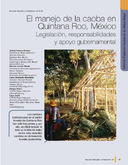| dc.contributor.author | Nolasco Morales, Alfredo | |
| dc.contributor.author | Carreón Mundo, Marcelo | |
| dc.contributor.author | Hernández Hernández, Carlos | |
| dc.contributor.author | Ibarra, Enrique | |
| dc.contributor.author | Snook, Laura | |
| dc.date.accessioned | 2021-04-29T22:36:38Z | |
| dc.date.available | 2021-04-29T22:36:38Z | |
| dc.date.issued | 2005-03 | |
| dc.identifier.issn | e-ISSN: 1021-0164 | |
| dc.identifier.uri | https://repositorio.catie.ac.cr/handle/11554/10750 | |
| dc.description | 7 páginas, ilustrado, 2 tabulaciones, 3 figuras, 14 referencias. | es_ES |
| dc.description.abstract | Las selvas de Quintana Roo han sido la fuente de
múltiples recursos forestales desde décadas. A
partir de 1984, los ejidos que son dueños de casi
la mitad de la superficie del estado, han tenido
el derecho de aprovechar los recursos maderables de sus selvas. Instituciones y programas del
gobierno, tanto federal como estatal, han apoyado
de varias formas el desarrollo forestal comunitario
en la zona. Como resultado, en el 2003 más de
160 ejidos y propietarios manejaban casi 750.000
ha de áreas forestales permanentes para el aprovechamiento de una variedad de productos maderables y no maderables cuyo valor en ese año era
de aproximadamente US$11,7 millones. De estos
ejidos, 36 producen un total de 8000 m3/año de
caoba (Swietenia macrophylla King) con un valor
de US$ 3 millones en el mercado doméstico. Este
artículo analiza los cambios en los marcos legales
e institucionales a través del tiempo, los avances
logrados y los retos por enfrentar todavía | es_ES |
| dc.description.sponsorship | The tropical forests of
Quintana Roo have been the source of multiple
resources for decades. Beginning in 1984, the
‘ejidos’ that control almost half of the area of the
state have had the right to sell the timber resources
from their communally-owned forests. Government
institutions and programs have supported community forestry development in various ways. As a
result, in 2003, more than 160 ejidos and property
owners manage almost 750,000 ha of permanent
production forests, from which they harvest a
variety of timber and non-timber forest products
worth US$11.7 million in 2003. Of those ejidos,
36 produce a total of 8,000 m3/year of mahogany
(Swietenia macrophylla King) with a value in 2003
of US$3 million in the domestic market. This article
describes the legal and institutional changes over
time, the advances achieved, and the challenges
still facing in community forestry in the region. | es_ES |
| dc.language.iso | es | es_ES |
| dc.publisher | CATIE, Turrialba (Costa Rica) | es_ES |
| dc.relation.ispartof | Revista Forestal Centroamericana Número 38 (abril-junio 2002), páginas 19-26 | |
| dc.rights | info:eu-repo/semantics/openAccess | es_ES |
| dc.subject | MANEJO FORESTAL | es_ES |
| dc.subject | LEGISLACION | es_ES |
| dc.subject | FORESTERIA SOCIAL | es_ES |
| dc.subject | PRODUCTOS FORESTALES NO MADERABLES | es_ES |
| dc.subject | DESARROLLO FORESTAL | es_ES |
| dc.subject | SWIETENIA MACROPHYLLA | es_ES |
| dc.subject | MEXICO | es_ES |
| dc.subject | RESPONSABILIDAD DE GESTION FORESTAL | es_ES |
| dc.subject | RESPONSABILIDAD LEGAL | es_ES |
| dc.title | El manejo de la caoba en Quintana Roo, México Legislación, responsabilidades y apoyo gubernamental | es_ES |
| dc.title.alternative | The management of mahogany in Quintana Roo, Mexico. Legislation, responsabilities and govermmernt support | es_ES |
| dc.type | Artículo | es_ES |


